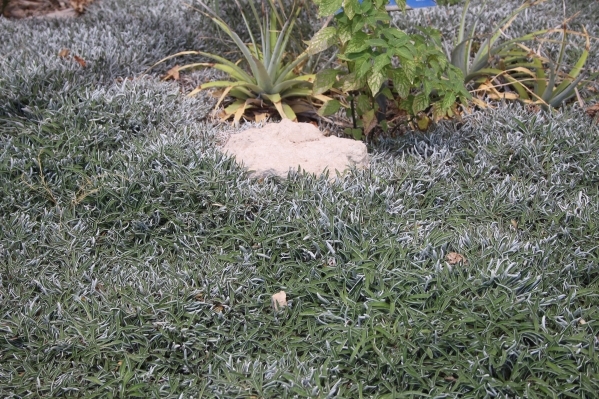Ground covers attractive option for desert landscaping
Despite years of encouragement to change water-guzzling landscapes to ones that are more appropriate for a desert, there are still local residents who think their only landscape choices in the Mojave are either a turf grass lawn or barren rock mulch. That limits their visual palette so much and unnecessarily eliminates attractive plants that can serve some of the functions of a lawn while adding color and texture.
It is true that ground covers are not lawns on which you can play touch football, but children and pets can play safely on at least some of them. They grow low to the ground, shading and cooling the soil, and they may even conserve water in the same way as mulch does. In fact, there are times when ground covers serve as living mulch.
Wherever rain falls in abundance, ground covers are popular; but even in this part of the desert, where water is rare and precious, we can grow many of these useful and pretty plants. Several are really drought tolerant, for instance those that come under the category of "ice plant."
Although ice plants are actually members of several different genera, most of them continue to flower through much of the scorching summer and other times as well. Each is very low-growing, rarely getting more than about 6 inches tall, with succulent leaves that enable it to hold water. All the ice plants, whether Lampranthus, Myoporum, Delosperma, Drosanthemum or Malephora, have this attractive habit.
The leaves are usually less than an inch long except for the Hottentot ice plant (properly known as Carpobrotus edulis), which has thick triangular leaves a couple of inches long or more and yellow flowers. A cousin of this is the magenta flowered C. chilensis, aka sea fig. Given the right conditions, either of these can spread into areas where it is undesirable, although experts consider the yellow-flowered plant to be more invasive.
Several additional possibilities would be attractive as a desert garden ground cover. One of these is Achillea tomentosa. This wooly yarrow will grow into a mat that spreads up to one and a half feet wide. Its yellow flowers appear on stems that might be as much as 10 inches tall.
Dymondia margaretae has yellow flowers and long, slender leaves — silvery green on top, with white undersides. It needs protection on the chilliest winter nights. Although it grows very low, no one would ever mistake it for a lawn. Fortunately, this ground cover can take a little traffic.
Artemesia caucasica, "silver spreader," is a cousin of sagebrush and wormwood, with interesting gray leaves and a unique, pleasant aroma. It rarely grows taller than 6 inches.
The flowers of the tough "cape weed" (Arctotheca calendula) look like a cross between yellow primrose and a dandelion, and it sounds tough as nails. It is not on Nevada's noxious weed list, although a few states and some countries treat it as an invasive pest.
Many ground covers also work well in rock gardens — as will a few members of the genus Arabis. So can the plant we call filaree. The first time I saw this, it was growing wild outside the Red Rock Canyon National Conservation Area visitor center. The Southwest Garden Book describes it as a dainty plant. The pink flowers are very simple, five petals, about ½ inch across. The plant itself does not exceed 6 inches in height. Some people think of filaree (Erodium reichardii) as a weed, but several cultivars are available.
We use lantana as a shrub, but some cultivars sprawl, growing low to the ground, making it a useful ground cover.
For areas that tend to be slightly shady, a lovely ground cover is Ajuga reptans. It has several common names, such as bugle and carpetweed. It is a very low-growing plant with scalloped leaves and purple flowers. In some parts of the country, it is considered an invasive species, but in our arid climate, this is highly unlikely. Many varieties are bred for sterility, which limits their invasive potential.
This might sound like a great many choices, but this is just a sampling of possible selections.
If you would like to try a little variety, decide whether your landscape would benefit from the addition of low-growing, flowering plants. Do a little research in gardening websites and nurseries before you buy anything to see whether it can survive our drought conditions and salty soils. Just because one can buy a plant does not mean it is ready for the Mojave.
You might not want to put in acres of ground cover, but in a small area, it can add a beautiful green, and many of them flower — better than turf grass, which, when you think about it, could be considered a ground cover. Ground covers also do not need regular mowing, only enough to deadhead any spent blossoms.
Angela O'Callaghan is the Social Horticulture Specialist for University of Nevada Cooperative Extension. Contact ocallaghana@unce.unr.edu or 702-257-5581.




























